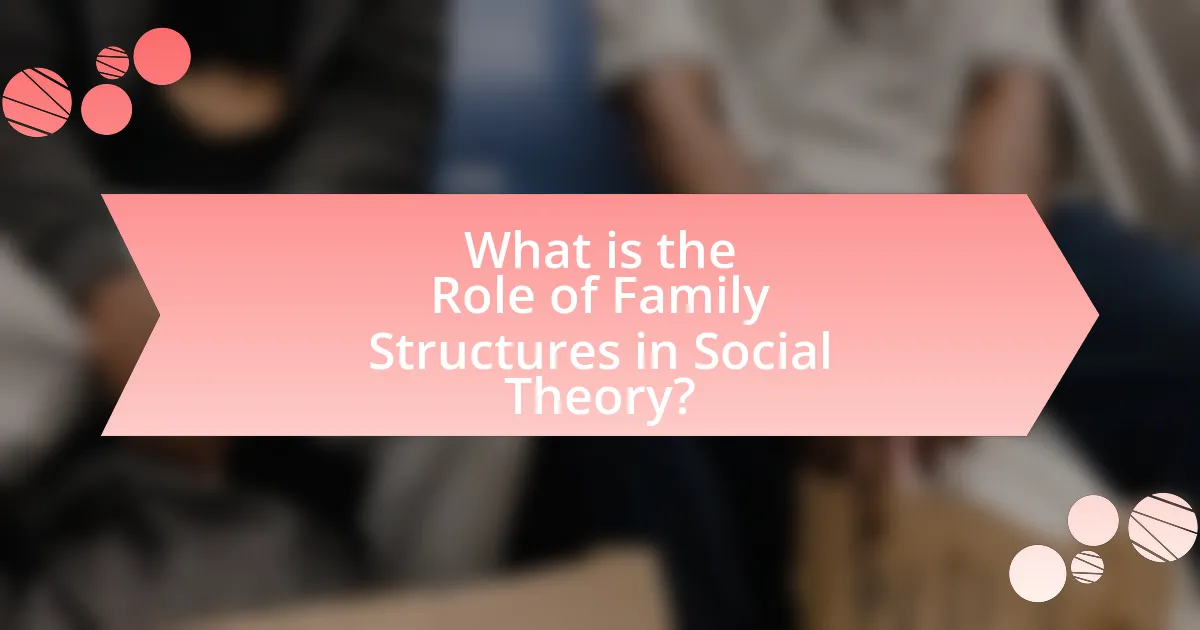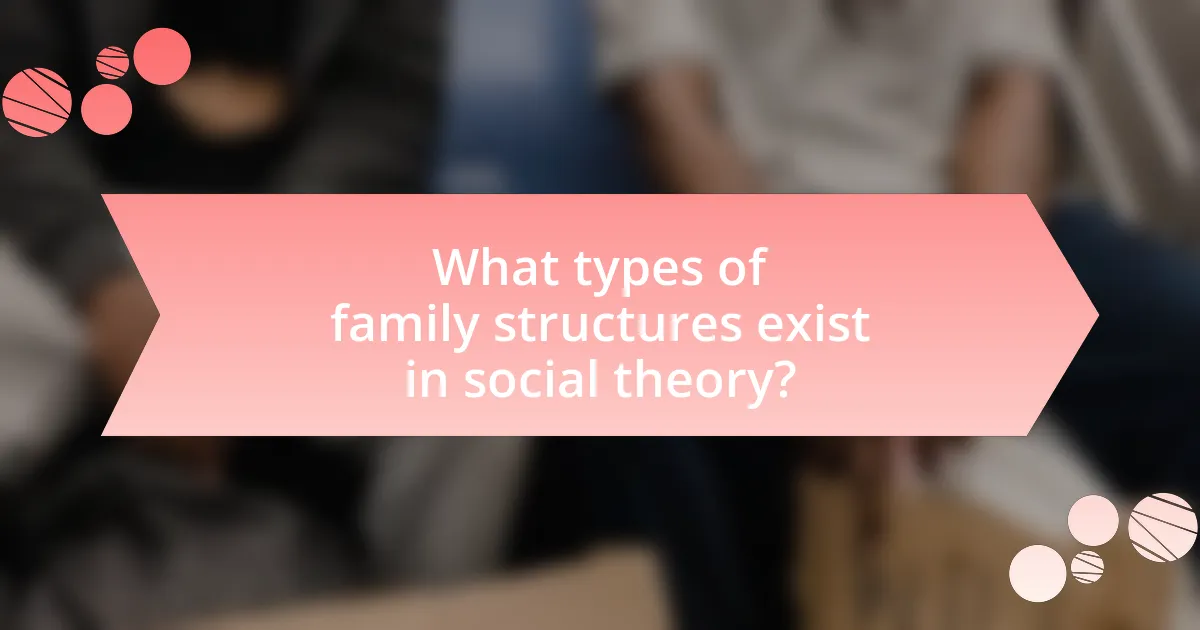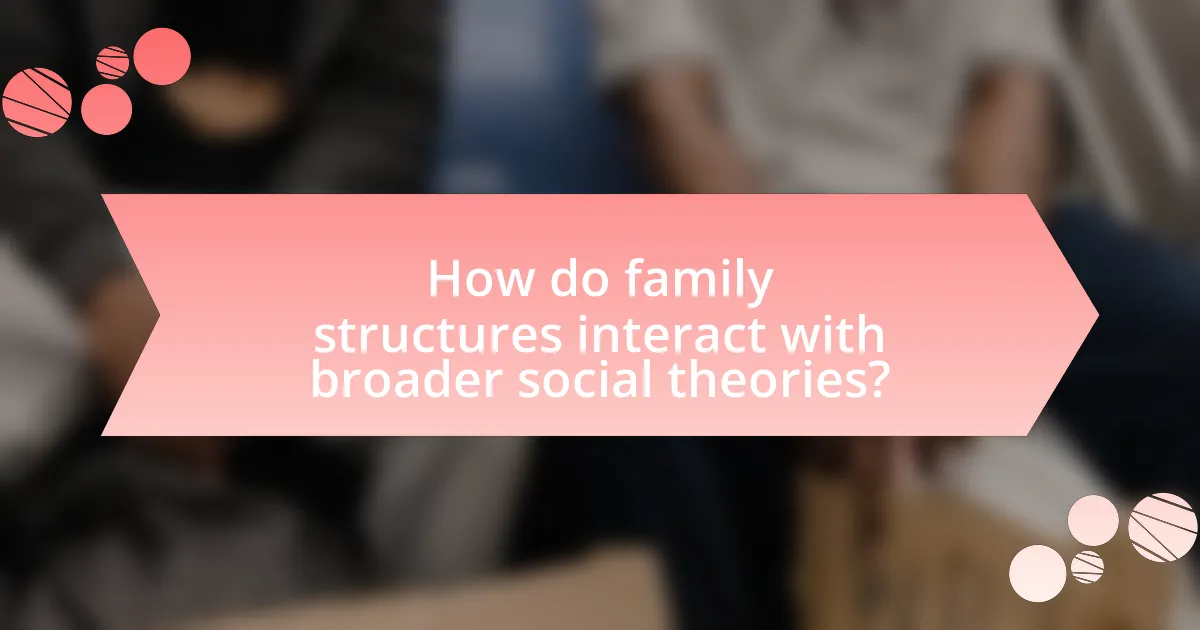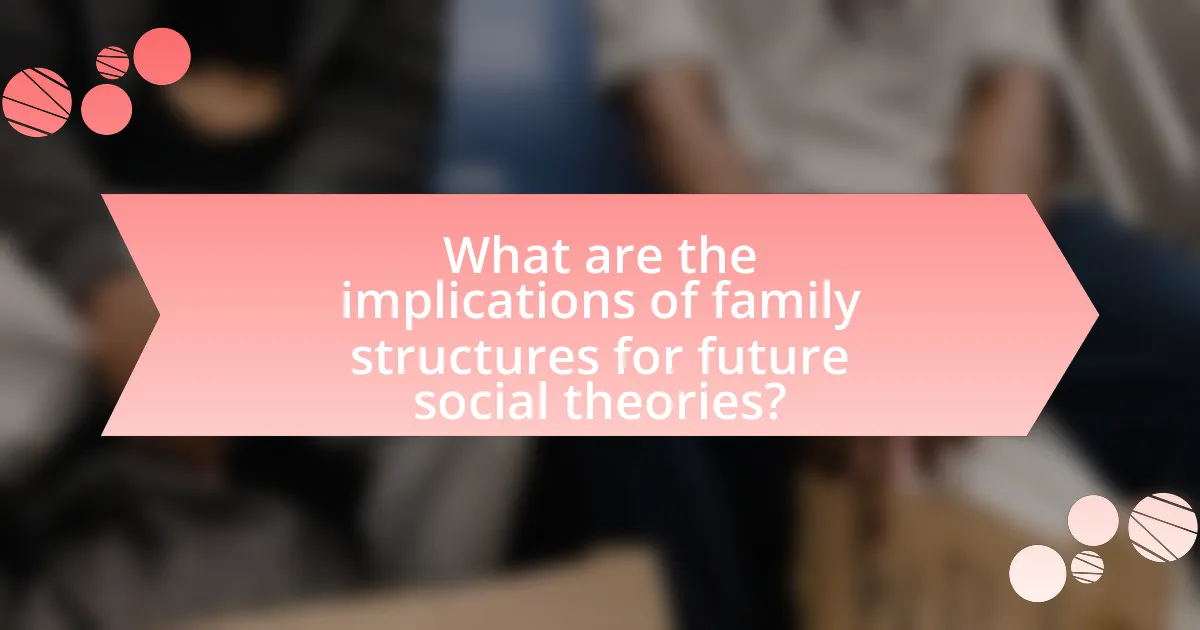Family structures are fundamental units of analysis in social theory, influencing individual behavior, socialization processes, and the transmission of cultural values. The article explores the role of family structures, including nuclear, extended, single-parent, and childless families, in shaping social dynamics and individual identities. It examines how these structures impact social cohesion, economic stability, and educational outcomes, while also addressing the historical perspectives and cultural variations that inform our understanding of family dynamics. Additionally, the article discusses the implications of family structures for social inequality, mobility, and policy development, highlighting the need for inclusive approaches to support diverse family forms.

What is the Role of Family Structures in Social Theory?
Family structures play a crucial role in social theory by serving as fundamental units of analysis for understanding social organization, relationships, and cultural norms. Social theorists, such as Emile Durkheim and Talcott Parsons, have emphasized that family structures influence individual behavior, socialization processes, and the transmission of values across generations. For instance, Durkheim’s work on social integration highlights how family units contribute to societal cohesion, while Parsons’ functionalist perspective illustrates the family’s role in maintaining social stability through defined roles and responsibilities. These theoretical frameworks demonstrate that family structures are not only vital for individual identity formation but also for the broader social fabric, impacting everything from economic behavior to educational outcomes.
How do family structures influence social dynamics?
Family structures significantly influence social dynamics by shaping individual behaviors, social roles, and community interactions. For instance, nuclear families often promote independence and self-reliance, while extended families can foster interdependence and collective responsibility. Research indicates that children raised in diverse family structures, such as single-parent or blended families, may develop different social skills and coping mechanisms, impacting their future relationships and societal contributions. A study by Amato (2000) in the Journal of Marriage and Family found that family structure is linked to children’s academic performance and emotional well-being, demonstrating the profound effects of family dynamics on broader social outcomes.
What are the key components of family structures in social theory?
The key components of family structures in social theory include roles, relationships, and norms. Roles refer to the expected behaviors and responsibilities of family members, such as parenting or caregiving. Relationships encompass the connections and interactions between family members, which can be influenced by factors like kinship and marriage. Norms are the shared expectations and rules that govern family behavior, shaping how members interact and fulfill their roles. These components are essential for understanding how families function within broader social contexts, as they influence socialization, support systems, and the transmission of cultural values.
How do different family structures affect individual behavior?
Different family structures significantly influence individual behavior by shaping socialization processes, emotional development, and identity formation. For instance, children raised in nuclear families often experience more direct parental involvement, which can lead to higher academic achievement and social competence. Conversely, those from single-parent or extended families may develop resilience and adaptability due to diverse caregiving experiences. Research by Amato (2000) in “The Consequences of Divorce for Adults and Children” highlights that children from stable two-parent households generally exhibit fewer behavioral problems compared to those from disrupted family structures. This evidence underscores the impact of family dynamics on individual behavior, illustrating how variations in family composition can lead to distinct behavioral outcomes.
Why are family structures considered foundational in social theory?
Family structures are considered foundational in social theory because they serve as the primary unit of social organization and influence individual behavior and societal norms. The family is often the first social institution individuals encounter, shaping their values, beliefs, and social roles. Research indicates that family dynamics significantly impact socialization processes, emotional development, and the transmission of cultural norms, as evidenced by studies such as those conducted by sociologist Emile Durkheim, who emphasized the role of familial ties in maintaining social cohesion. Additionally, family structures affect economic stability and social mobility, as families provide essential support systems that can either facilitate or hinder access to resources and opportunities.
What historical perspectives shape our understanding of family structures?
Historical perspectives that shape our understanding of family structures include the evolution of kinship systems, the impact of industrialization, and the influence of cultural norms. Kinship systems, such as those observed in hunter-gatherer societies, emphasized extended family networks, which provided social support and resource sharing. With industrialization in the 19th century, family structures shifted towards nuclear families, reflecting economic changes and urban migration patterns. Cultural norms, influenced by religion and societal values, further define family roles and expectations, as seen in various historical contexts, such as the patriarchal family model prevalent in many societies. These perspectives illustrate how family structures are not static but evolve in response to economic, social, and cultural changes throughout history.
How do cultural variations impact family structures in social theory?
Cultural variations significantly impact family structures in social theory by shaping the roles, relationships, and expectations within families. Different cultures prioritize various family forms, such as nuclear, extended, or single-parent families, influencing social dynamics and individual identities. For instance, in collectivist societies, extended families often play a crucial role in providing support and maintaining social cohesion, while in individualistic cultures, nuclear families may emphasize autonomy and personal achievement. Research by sociologist William Fielding Ogburn highlights how cultural norms dictate family roles, illustrating that societal values directly affect family organization and function.

What types of family structures exist in social theory?
In social theory, the primary types of family structures include nuclear families, extended families, single-parent families, and childless families. Nuclear families consist of two parents and their children, which is often considered the traditional family unit. Extended families encompass multiple generations living together or in close proximity, including grandparents, aunts, uncles, and cousins. Single-parent families are headed by one parent raising their children, which has become increasingly common due to various social factors. Childless families, whether by choice or circumstance, consist of couples without children. These classifications are supported by sociological research, such as the work of sociologist William J. Goode, who highlighted the diversity of family forms in his studies on family structures and their implications for social dynamics.
How do nuclear families differ from extended families in social contexts?
Nuclear families differ from extended families in social contexts primarily in their structure and social dynamics. A nuclear family consists of two parents and their children, which fosters a more intimate and immediate family environment, often leading to stronger emotional bonds and focused parenting. In contrast, extended families include additional relatives such as grandparents, aunts, uncles, and cousins, which can create a broader support network and diverse social interactions.
Research indicates that nuclear families tend to emphasize individualism and self-reliance, while extended families often promote collectivism and shared responsibilities. For example, studies show that in cultures with strong extended family ties, such as in many Asian and African societies, family decisions are made collectively, reflecting a communal approach to social issues. This structural difference influences various aspects of life, including child-rearing practices, resource sharing, and social support systems, ultimately shaping the social fabric of communities.
What are the advantages and disadvantages of nuclear families?
Nuclear families, consisting of two parents and their children, offer several advantages and disadvantages. One significant advantage is economic efficiency; nuclear families often share resources, leading to lower living costs per individual compared to extended families. Additionally, they provide a focused environment for child-rearing, which can enhance emotional bonding and stability for children. Research indicates that children in nuclear families tend to perform better academically and socially due to the concentrated parental attention and support.
Conversely, a notable disadvantage of nuclear families is the potential for social isolation. Without the support of extended family members, nuclear families may experience increased stress and a lack of emotional support during challenging times. Furthermore, the division of labor can lead to unequal distribution of household responsibilities, which may create tension between partners. Studies show that nuclear families can face higher rates of divorce, which can negatively impact children’s well-being and development.
How do extended families provide support in various cultures?
Extended families provide support in various cultures by fostering intergenerational relationships that enhance emotional, financial, and social stability. In many cultures, such as in African and Asian societies, extended families often live together or maintain close proximity, allowing for shared resources and caregiving responsibilities. This structure enables members to pool financial resources, which can alleviate economic burdens, as seen in studies indicating that extended family networks can significantly reduce poverty levels in communities. Additionally, emotional support is strengthened through daily interactions and shared experiences, which are crucial during life transitions such as childbirth, illness, or bereavement. Research by the Pew Research Center highlights that in cultures with strong extended family ties, individuals report higher levels of life satisfaction and lower levels of stress, demonstrating the psychological benefits of these familial connections.
What role do single-parent families play in social theory?
Single-parent families play a significant role in social theory by challenging traditional family structures and highlighting the diversity of family dynamics. They serve as a focal point for examining issues such as social inequality, child development, and the impact of economic factors on family life. Research indicates that single-parent households often face unique challenges, including financial instability and social stigma, which can affect children’s educational and emotional outcomes. For instance, studies show that children from single-parent families may experience higher rates of poverty, which can influence their access to resources and opportunities, thereby shaping broader societal patterns. This understanding of single-parent families contributes to social theories that address the complexities of modern family life and the implications for social policy and community support systems.
How do single-parent families challenge traditional family norms?
Single-parent families challenge traditional family norms by redefining the structure and dynamics of family life. Traditionally, families have been viewed as two-parent households, often with a clear division of roles between mothers and fathers. However, single-parent families disrupt this norm by demonstrating that effective parenting and family cohesion can occur outside of this conventional framework. Research indicates that approximately 23% of children in the United States live with a single parent, highlighting the prevalence of this family structure and its impact on societal perceptions of family. This shift prompts a reevaluation of gender roles, economic responsibilities, and the definition of family itself, illustrating that love and support can exist in diverse forms beyond traditional expectations.
What social support systems are available for single-parent families?
Single-parent families have access to various social support systems, including government assistance programs, community resources, and non-profit organizations. Government programs such as Temporary Assistance for Needy Families (TANF) provide financial aid, while the Supplemental Nutrition Assistance Program (SNAP) offers food assistance. Community resources often include local food banks, housing assistance, and childcare services. Non-profit organizations, such as Single Parent Advocate and the National Single Parent Resource Center, offer support networks, educational resources, and advocacy for single parents. These systems are designed to alleviate the challenges faced by single-parent families, providing essential support for their well-being and stability.

How do family structures interact with broader social theories?
Family structures interact with broader social theories by serving as foundational units that reflect and influence societal norms, values, and power dynamics. For instance, functionalism posits that family structures contribute to social stability by fulfilling essential functions such as socialization and emotional support. In contrast, conflict theory highlights how family structures can perpetuate social inequalities, as seen in the transmission of wealth and status across generations. Empirical studies, such as those by sociologist William J. Goode, demonstrate that variations in family structures—like nuclear versus extended families—affect social cohesion and individual behavior, thereby validating the interplay between family dynamics and social theories.
What is the relationship between family structures and social stratification?
Family structures significantly influence social stratification by determining access to resources, social networks, and opportunities. Different family types, such as nuclear, extended, or single-parent families, can affect economic stability and educational attainment, which are key factors in social class positioning. For instance, research indicates that children from stable, two-parent households tend to have better educational outcomes and higher earning potential, contributing to upward mobility within social hierarchies. Conversely, single-parent families often face economic challenges that can perpetuate cycles of poverty and limit social mobility, reinforcing existing stratification. This relationship highlights how family dynamics shape individual life chances and societal structures.
How do family structures contribute to social inequality?
Family structures contribute to social inequality by influencing access to resources, education, and social capital. For instance, children raised in single-parent households often face economic disadvantages, leading to lower educational attainment and limited job opportunities. Research indicates that children from two-parent families typically have better access to financial resources and support systems, which enhances their chances of success. According to the U.S. Census Bureau, children in single-parent families are more likely to live in poverty, with 29% of children living with a single mother compared to 6% living with both parents. This disparity in family structure directly correlates with differences in socioeconomic status, perpetuating cycles of inequality across generations.
What role do family structures play in social mobility?
Family structures significantly influence social mobility by shaping access to resources, education, and social networks. For instance, children from stable, two-parent households often experience better educational outcomes and financial stability, which are critical factors in upward mobility. Research indicates that children raised in single-parent families are more likely to face economic hardships and lower educational attainment, which can hinder their social mobility. A study by the Pew Research Center found that children from intact families are more likely to graduate from college, thereby increasing their chances of achieving higher socioeconomic status. Thus, the composition and stability of family structures play a crucial role in determining the social mobility of individuals.
How do family structures influence social change?
Family structures significantly influence social change by shaping individual behaviors, values, and societal norms. For instance, the transition from traditional nuclear families to diverse family forms, such as single-parent households and same-sex couples, has led to shifts in societal acceptance and legal reforms, including marriage equality and child custody laws. Research by sociologist Andrew Cherlin highlights that changing family dynamics, such as increased divorce rates and cohabitation, have redefined concepts of family and contributed to evolving gender roles, impacting workforce participation and economic policies. These transformations illustrate how family structures act as catalysts for broader social change, reflecting and driving shifts in cultural attitudes and institutional frameworks.
What examples illustrate the impact of changing family structures on society?
Changing family structures, such as the rise of single-parent households and same-sex families, significantly impact society by altering social norms and economic dynamics. For instance, the increase in single-parent families has been linked to higher rates of poverty and changes in child-rearing practices, which can affect children’s educational outcomes. According to the U.S. Census Bureau, in 2020, approximately 23% of children lived with a single mother, highlighting a shift from traditional two-parent households. Additionally, the acceptance of same-sex families has led to broader discussions on marriage equality and legal rights, influencing legislation and social attitudes. Research from the Williams Institute indicates that legal recognition of same-sex marriage has positively affected mental health and economic stability for families, demonstrating a societal shift towards inclusivity.
How do family structures adapt to technological advancements?
Family structures adapt to technological advancements by altering communication patterns, redefining roles, and changing parenting practices. For instance, the rise of smartphones and social media has led families to engage in more digital communication, which can strengthen relationships but also create challenges such as reduced face-to-face interactions. Research indicates that 72% of teens use social media, impacting family dynamics by fostering both connection and conflict. Additionally, technology has enabled remote work, allowing parents to spend more time at home, which can shift traditional roles and responsibilities within the family unit. These adaptations illustrate how family structures evolve in response to the changing technological landscape, reflecting broader social changes.

What are the implications of family structures for future social theories?
Family structures significantly influence future social theories by shaping the understanding of social dynamics, identity formation, and community interactions. As family structures evolve—such as the rise of single-parent households, blended families, and same-sex partnerships—social theories must adapt to account for diverse experiences and perspectives. Research indicates that these variations in family composition affect socialization processes, economic stability, and emotional well-being, which are critical factors in developing comprehensive social theories. For instance, studies show that children from diverse family structures may experience different educational and social outcomes, prompting theorists to reconsider traditional models that primarily focus on nuclear families. Thus, the implications of family structures are profound, necessitating a reevaluation of existing social theories to encompass a broader range of human experiences and societal norms.
How can understanding family structures improve social policies?
Understanding family structures can improve social policies by enabling policymakers to tailor programs that address the specific needs and dynamics of different family types. For instance, research indicates that single-parent families often face unique economic challenges, which can be addressed through targeted financial assistance programs. According to the U.S. Census Bureau, in 2020, 23% of children lived in single-parent households, highlighting the necessity for policies that support these families. By recognizing the diversity in family structures, such as nuclear, extended, and blended families, social policies can be designed to promote stability, access to resources, and overall well-being, ultimately leading to more effective interventions and support systems.
What best practices can be implemented to support diverse family structures?
To support diverse family structures, implementing inclusive policies and practices is essential. These practices include providing access to comprehensive family support services that recognize various family forms, such as single-parent families, blended families, and same-sex parent families. Research indicates that inclusive policies, such as those promoting equitable access to healthcare, education, and social services, significantly improve the well-being of children and parents in diverse family settings. For instance, the American Psychological Association highlights that children from diverse family structures benefit from supportive environments that affirm their family identity, leading to better psychological outcomes. Additionally, fostering community awareness and acceptance through educational programs can reduce stigma and promote understanding of different family dynamics.
How can researchers better study the impact of family structures on society?
Researchers can better study the impact of family structures on society by employing longitudinal studies that track changes over time within diverse family units. This approach allows for the examination of how different family structures, such as single-parent households or blended families, influence social outcomes like education, economic stability, and mental health. For instance, a study published in the Journal of Marriage and Family found that children from stable two-parent families tend to have better academic performance compared to those from single-parent families, highlighting the importance of family structure in societal development. Additionally, incorporating qualitative methods, such as interviews and case studies, can provide deeper insights into the lived experiences of individuals within various family dynamics, further enriching the understanding of their societal impact.
What practical insights can be drawn from the study of family structures in social theory?
The study of family structures in social theory reveals practical insights into social dynamics, cultural norms, and individual behavior. Family structures, such as nuclear, extended, and single-parent families, influence socialization processes, economic stability, and community engagement. For instance, research indicates that children from stable family environments tend to perform better academically and socially, highlighting the role of family in shaping future societal contributors. Additionally, understanding diverse family structures can inform policies aimed at supporting various family types, thereby enhancing social welfare and cohesion.
